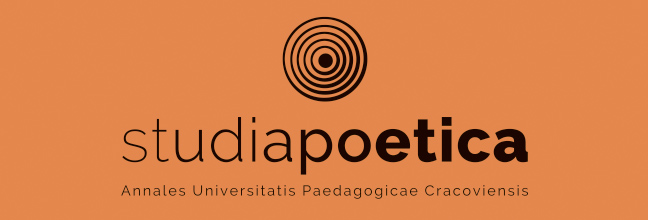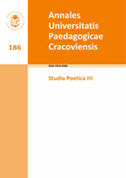Sanok i Brugia – peryferyjne miasta Mariana Pankowskiego
Main Article Content
Abstrakt
Sanok and Brugge - the peripheral towns of Marian Pankowski
The article presents an analysis of two urban images pictured in Marian Pankowski’s prose. His home town, Sanok, being the town of his youth, is shown in his experimental novel Matuga idzie (Here comes Matuga) dating to 1956-57, while the medieval Brugge is presented in Putto, written in 1994. The former is the place of the writer’s initiation in the nature and sexuality, while the latter, with its architecture, brings to mind the old painters’ engravings and thus shows as a product of high culture. The writer does not aim at a realistic reconstruction of space, but treats it as a pretext to argue with the fossilized forms which limit the subjective expression of an individual. In the first novel mentioned, he revises the Romantic sense of national community, while in the Belgian novel he discloses the appearances of the bourgeois world order. In both cases the writer surfaces the hidden complexes by reaching to the sphere of the Night, as he calls this subcutaneous world. He explores peripheral topics and moves beyond the ordered urban landscape towards the phenomena difficult to rationalize. He confronts the subjective ”self” with the disenchanted post-War world. He triggers a clash between the youthful idealism and the difficult knowledge elicited from the political history lesson and from the observation of contemporary social behaviours. He is inclined to adopt the subjectivist perspective and manifests individualism and eccentricity. He questions the fossilized beliefs in the name of the truth of body and senses. Owing to this, he gains distance towards the mainstream of Polish Romanticism. However, he remains a follower of the Romantic project of consciousness regarded as the expressive and creative principle. He demonstrates it when he deprives the well-known topoi of the ”family Arcadia” or the ”idyllic childhood” of their aura of familiarity. He leads his hero out of cosy places to throw him against what is alien, unbelievable, or perverse. The accompanying feeling is that of ethic and cognitive uncertainty: an integral element of the human condition. This pessimistic interpretation is not a negative conclusion with respect to this writer. If critical thinking is believed to shape individual separateness, then Pankowski’s prose is evidence of individualistic inventiveness, rooted in the Romantic spirit. In an artistic strategy designed so, the urban images are a projection of the subjective ”self”, which respects their material reality, but at the same time inscribes in them its own emotions.
Downloads
Article Details
Wydawca „Annales Universitatis Paedagogicae Cracoviensis. Studia Poetica” jest upoważniony do korzystania oraz do rozpowszechniana wszystkich opublikowanych w czasopiśmie materiałów na podstawie umowy licencji niewyłącznej nieograniczonej w czasie - zawartej uprzednio na czas nieoznaczony każdorazowo z autorem/ką konkretnego utworu na określonych w tamtejszej umowie polach eksploatacji.
POLITYKA OTWARTEGO DOSTĘPU
„Annales Universitatis Paedagogicae Cracoviensis. Studia Poetica” to czasopismo o otwartym dostępie, a cała jego zawartość jest dostępna bezpłatnie dla użytkowników i instytucji na zasadach Creative Commons Attribution CC-BY 4.0. (uznanie autorstwa). Użytkownicy/ki mogą czytać, pobierać, wykonywać kopie, rozpowszechniać, drukować, wyszukiwać lub linkować do pełnych tekstów artykułów w tym czasopiśmie bez uprzedniej zgody wydawcy lub autora/ki pod warunkiem podania źródła dostępu i autorstwa danej publikacji. Jest to zgodne z definicją otwartego dostępu BOAI (http://www.soros.org/openaccess).
Bibliografia
Bielik-Robson Agata, Duch powierzchni. Rewizja romantyczna i filozofia, Kraków 2004.
##plugins.generic.googleScholarLinks.settings.viewInGS##
Bielik-Robson Agata, Inna nowoczesność. Pytania o współczesną formułę duchowości, Kraków 2000.
##plugins.generic.googleScholarLinks.settings.viewInGS##
Brygidyn Andrzej, Sanok między wojną a stanem wojennym, Krosno 1999.
##plugins.generic.googleScholarLinks.settings.viewInGS##
Mojsak Kajetan, „Przygody ciała” – podmiotowość i groteska w powieści „Matuga idzie” Mariana Pankowskiego, „Pamiętnik Literacki” 2008, z. 4.
##plugins.generic.googleScholarLinks.settings.viewInGS##
Pankowski Marian, Była Żydówka, nie ma Żydówki, Warszawa 2008.
##plugins.generic.googleScholarLinks.settings.viewInGS##
Pankowski Marian, Do czytelnika, [w:] Marian Pankowski, Matuga idzie. Przygody, Bruksela 1959.
##plugins.generic.googleScholarLinks.settings.viewInGS##
Pankowski Marian, Powrót białych nietoperzy, Londyn 1991.
##plugins.generic.googleScholarLinks.settings.viewInGS##
Pankowski Marian, Putto, „Softpress”, Poznań 1994.
##plugins.generic.googleScholarLinks.settings.viewInGS##
Pankowski Marian, Rudolf, Warszawa 1984.
##plugins.generic.googleScholarLinks.settings.viewInGS##
Pankowski Marian, Scenariusz martwego dzieciństwa, [w:] Pisarska rozróba. W 70-lecie urodzin Mariana Pankowskiego, red. Stanisław Barć, Tomasz Korzeniowski, Bronisław Przystasz, Sanok 1990.
##plugins.generic.googleScholarLinks.settings.viewInGS##
Pankowski Marian, Teatrowanie nad świętym barszczem. Wybór utworów dramatycznych, posłowie Krystyna Latawiec, Kraków 1995.
##plugins.generic.googleScholarLinks.settings.viewInGS##
Pankowski Marian, Z Auszwicu do Belsen (przygody), „Twórczość” 1998, nr 5.
##plugins.generic.googleScholarLinks.settings.viewInGS##
Pankowski Marian, Z Auszwicu do Belsen (przygody), Warszawa 2000.
##plugins.generic.googleScholarLinks.settings.viewInGS##
Pankowski Marian, Złoto żałobne, Koszalin 2002.
##plugins.generic.googleScholarLinks.settings.viewInGS##
Pieniek Jarosław, Beginki, http://www.katolik.pl/index1.php?st=artykuly&id=1075 (dostęp: 23.04.2015).
##plugins.generic.googleScholarLinks.settings.viewInGS##
Polak w dwuznacznych sytuacjach. Z Marianem Pankowskim rozmawia K. Ruta-Rutkowska, posł. Anna Nasiłowska, Warszawa 2000.
##plugins.generic.googleScholarLinks.settings.viewInGS##
Ruta-Rutkowska Krystyna, Dramaturgia Mariana Pankowskiego: problemy poetyki dramatu współczesnego, Warszawa 2001.
##plugins.generic.googleScholarLinks.settings.viewInGS##

